There are many must-visit islands in Alaska, particularly for those seeking nature and outdoor experiences. There is plentiful untouched wilderness and abundant biodiversity here, awaiting intrepid explorers. From Kodiak Island’s magnificent bears to Prince of Wales Island’s diverse outdoor playground, each destination offers a unique Alaskan experience.
Traverse the rugged terrains of Admiralty Island and Revillagigedo Island, where wildlife encounters and breathtaking vistas promise unforgettable memories. Immerse yourself in the untamed allure of Baranof Island and Wrangell Island’s hidden gems. Or even find remote adventures on Adak Island or Fox Island. Prepare to be captivated by the raw beauty of Alaska’s pristine islands, which is often a journey through the heart of raw wilderness.
| Island | Size |
|---|---|
| Kodiak Island | 3,595 square miles (9,311 square kilometers) |
| Prince of Wales Island | 2,577 square miles (6,670 square kilometers) |
| Chichagof Island | 2,048 square miles (5,305 square kilometers) |
| Admiralty Island | 1,646 square miles (4,264 square kilometers) |
| Baranof Island | 1,607 square miles (4,160 square kilometers) |
| Revillagigedo Island | 1,060 square miles (2,754 square kilometers) |
| Adak Island | 275 square miles (711 square kilometers) |
| Wrangell Island | 210 square miles (544 square kilometers) |
| Douglas Island | 77 square miles (199 square kilometers) |
| Fox Island | 3.2 miles long (5.1 kilometers) by 2 miles wide (3.2 kilometers) |
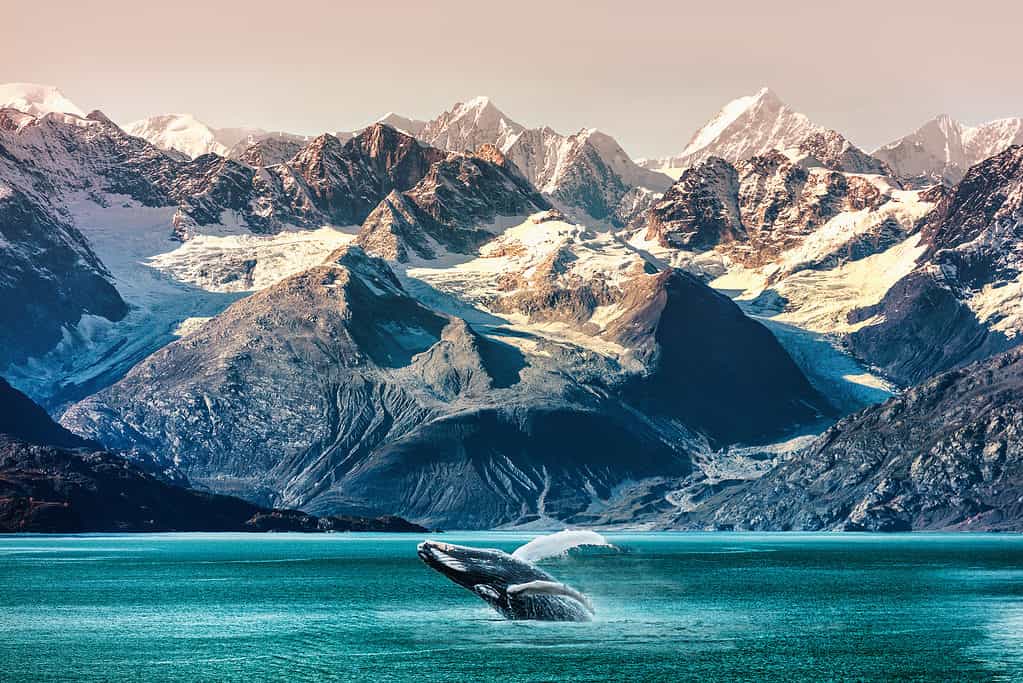
Alaska is home to many islands.
©Maridav/Shutterstock.com

Kodiak Island
With its untamed wilderness, captivating wildlife, and rich history, Kodiak Island remains an unparalleled destination for those seeking an authentic Alaskan adventure. It lies southwest of Anchorage, Alaska’s largest city, and is separated from the mainland by the Shelikof Strait. With an area of approximately 3,595 square miles (9,311 square kilometers), Kodiak Island is the second-largest island in the United States, only surpassed by the Big Island of Hawaii. It is also the 80th largest island in the world.
Attractions on Kodiak Island
This island is a haven of uniqueness, boasting many captivating features that draw adventurers and nature enthusiasts worldwide. One of its most striking characteristics is the Kodiak bear (Ursus arctos middendorffi), a subspecies of the brown bear and one of the largest land carnivores on Earth. These majestic creatures roam the island’s rugged terrain and lush forests, making it an exceptional destination for wildlife lovers seeking unforgettable sightings of these awe-inspiring animals.
Furthermore, Kodiak Island offers a wide range of attractions for visitors seeking to immerse themselves in nature’s wonders. The Kodiak National Wildlife Refuge, sprawling roughly 1.9 million acres, is a sanctuary for diverse wildlife, including seabirds, marine mammals, and even Mountain goats (Oreamnos americanus). Adventurers can explore the refuge through camping, backpacking, or even aircraft tours, gaining an intimate experience with Alaska’s untamed wilderness.
For those drawn to water activities, Kodiak Island does not disappoint. Its pristine coastlines offer ample opportunities for fishing, kayaking, and whale-watching. The island’s waters teem with marine life, providing a thrilling playground for ocean enthusiasts.
History enthusiasts will find charm in Kodiak’s historic sites. Fort Abercrombie State Historical Park, established during World War II, exhibits remnants of military installations and offers panoramic vistas of the island’s coastline. The Kodiak History Museum delves into the island’s rich cultural heritage and the fascinating stories of its indigenous peoples.
The flora of Kodiak Island is as intriguing as its fauna. Unique plant species, such as the Western Skunk Cabbage (Lysichiton americanus), thrive in the island’s damp, coastal environment. The vibrant Nootka lupine (Lupinus nootkatensis) graces the landscapes with its striking purple blooms, adding to the island’s allure.
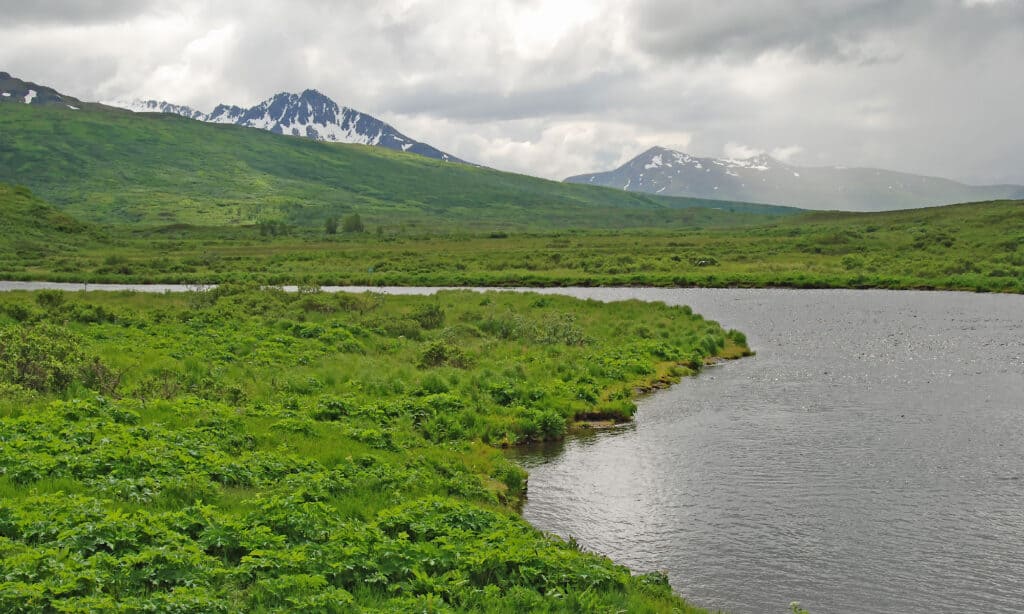
Kodiak Island consists of mountainous regions, forested areas in the north and east, and lowlands in the south.
©iStock.com/Wildnerdpix
Prince of Wales Island
First on our list of must-visit islands in Alaska is Prince of Wales Island. Nestled in the southeastern part of Alaska, the majestic Prince of Wales Island beckons visitors with its awe-inspiring beauty and untamed wilderness. This island is the fourth-largest in the United States, covering an impressive area of around 2,577 square miles (6,670 square kilometers).
Attractions on Prince of Wales Island
One of the most captivating aspects of Prince of Wales Island is its lush and diverse landscape. Towering mountains, dense forests, and pristine lakes create a breathtaking backdrop for those seeking nature. The island’s enchanting charm lies in its unique blend of coastal beauty and rugged interiors.
Located on Prince of Wales Island, the Tongass National Forest, the largest national forest in the United States, encompasses a significant part of the island and covers roughly 17 million acres. This protected area provides abundant camping, backpacking, and hiking opportunities, allowing adventurers to immerse themselves in the splendor of Alaska’s temperate rainforests.
The island’s intricate coastline and numerous bays offer a haven for water activities. Kayaking through the serene waters provides a chance to witness the wonders of marine life up close. Those who enjoy fishing will be delighted by the island’s abundant fishing opportunities, with salmon and trout being popular catches. With its impressive landscape, aircraft tours are an excellent opportunity to cover massive areas of scenic landscapes from a unique perspective.
Moreover, Prince of Wales Island has cultural sites for those with a penchant for history. Native American totem poles and ancient petroglyphs offer a glimpse into the island’s rich indigenous heritage, providing a deeper appreciation of its history.
In the wilds of Prince of Wales Island, unique animal species flourish. The Alexander Archipelago wolf (Canis lupus ligoni) is a subspecies of gray wolves adapted to the island’s unique habitat. Other notable inhabitants include the Prince of Wales flying squirrel (Glaucomys sabrinus griseifrons), a subspecies of the northern flying squirrel observed in the island’s dense forests.
The island is home to species like the Alaska rein-orchid (Platanthera unalascensis) and various sedge species (Carex spp.) dotting its landscapes.
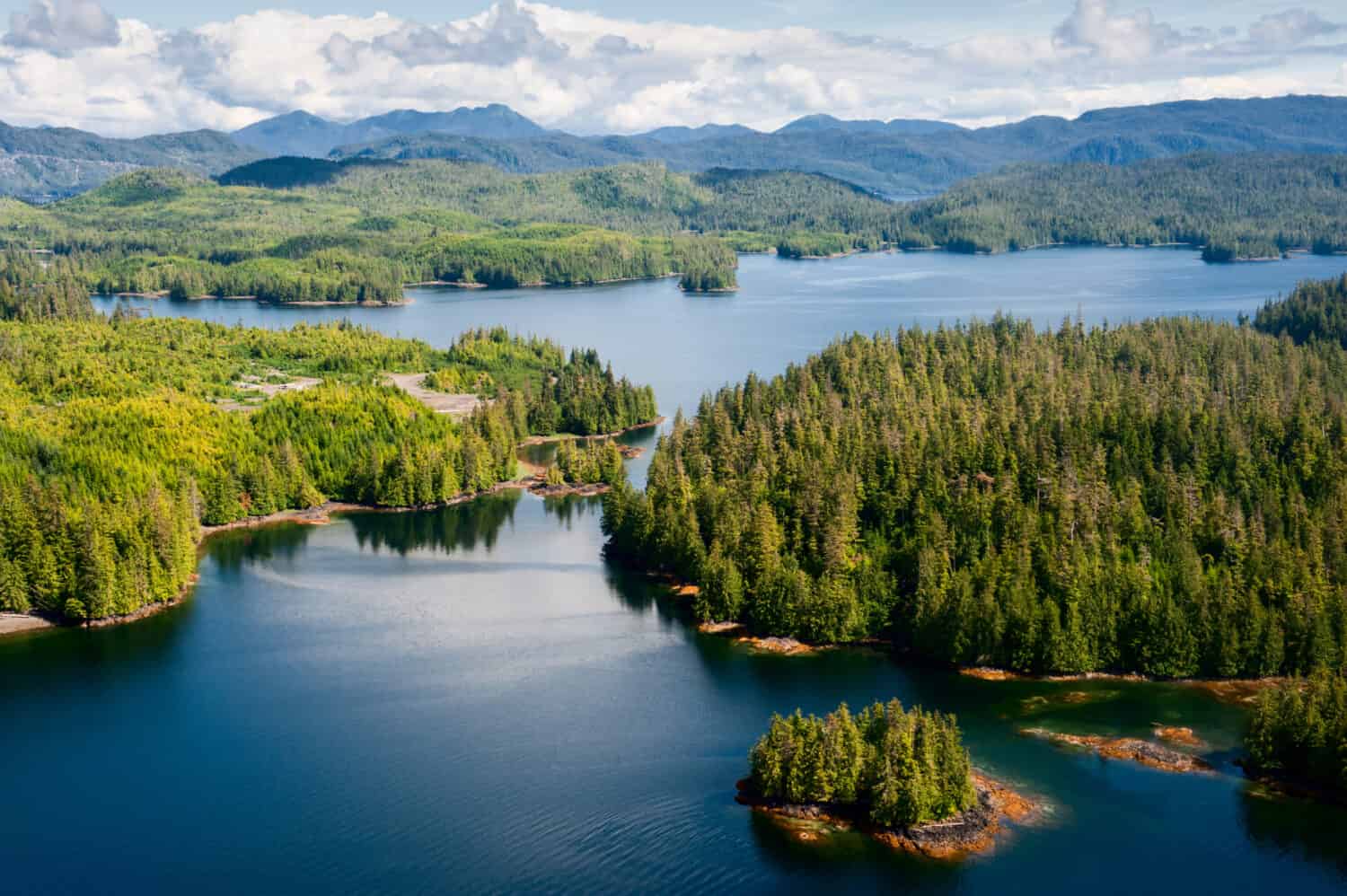
Prince of Wales Island consists of 2,577 square miles (6,670 square kilometers).
©Andrea Izzotti/Shutterstock.com
Admiralty Island
In the heart of Alaska’s Inside Passage lies the captivating Admiralty Island, a hidden treasure awaiting adventurers with its untouched beauty. This island is second on our list of must-visit islands in Alaska, and it is situated in the southeastern region of Alaska. It is flanked by the Chatham Strait and the Glass Peninsula. The Seymour Canal nearly splits the island itself in two. Covering an expansive area of approximately 1,646 square miles (4,264 square kilometers), Admiralty Island is a true haven for those seeking an authentic Alaskan experience.
Attractions on Admiralty Island
What sets Admiralty Island apart is its awe-inspiring concentration of wildlife, earning it the nickname “Fortress of the Bears.” One of its most remarkable inhabitants is the grizzly bear (Ursus arctos horribilis). These majestic giants thrive in astonishing numbers on the island, making it one of the best places on Earth to observe and study these magnificent creatures in their natural habitat. Bear-watching is a favorite activity for visitors, offering the rare chance to witness these bears’ awe-inspiring behaviors, such as salmon fishing during the annual salmon runs.
Moreover, Admiralty Island is a wilderness sanctuary, with Admiralty Island National Monument and Admiralty Island Wilderness offering refuge to diverse wildlife. Outdoor enthusiasts are enchanted by the opportunity for camping, backpacking, hunting, winter activities, and exploring the island’s breathtaking landscapes by land, sea, or air.
For those fascinated by marine life, Admiralty Island’s waters teem with marine mammals, including humpback whales (Megaptera novaeangliae) and killer whales (Orcinus orca), providing captivating whale-watching opportunities.
The island’s forests house unique plant species, such as the Sitka mountain ash (Sorbus sitchensis), adding to the island’s allure. The pristine ecosystem sustains various flora and fauna, with stunning wildflower displays during the warmer months.
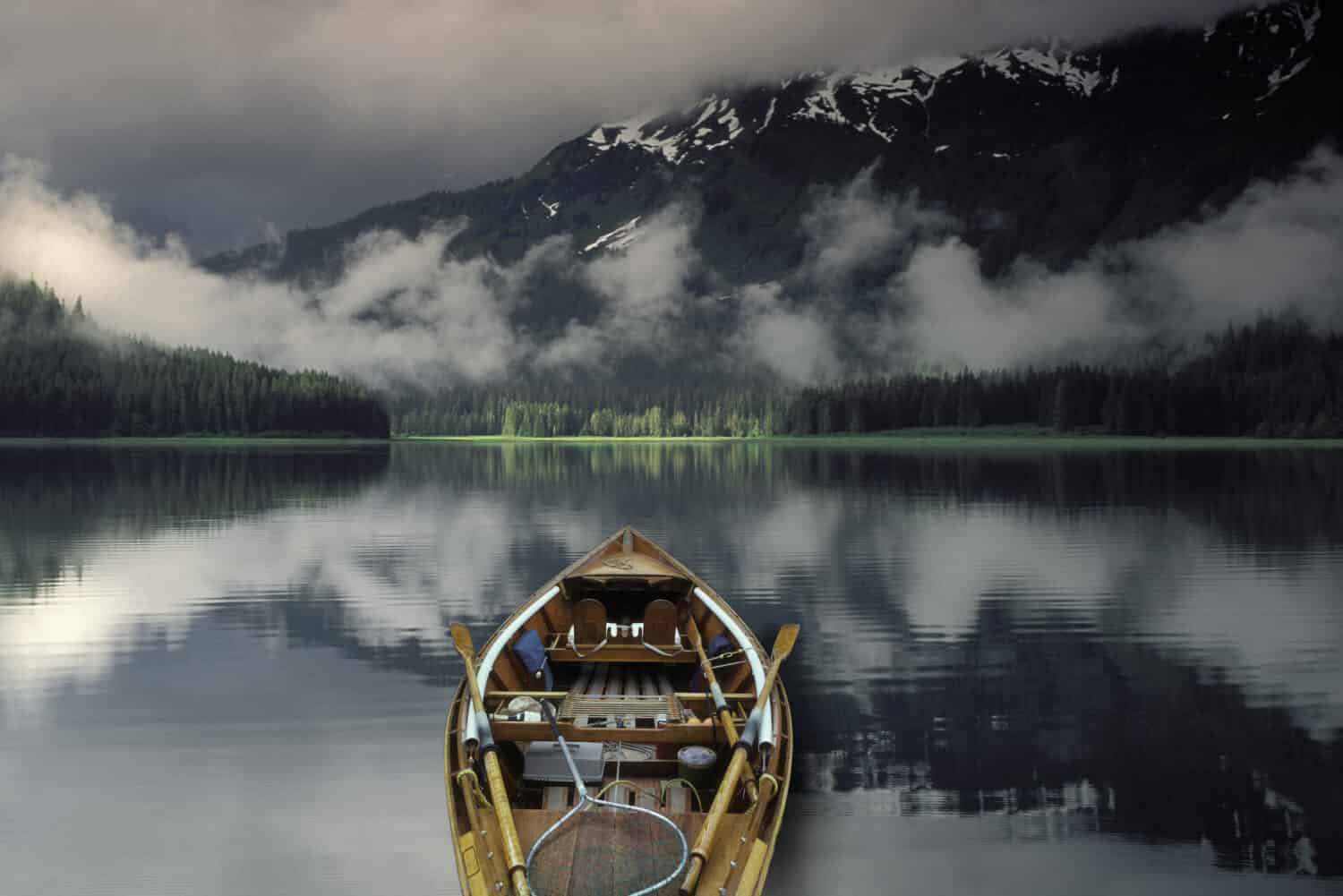
Kayaking and canoeing are incredibly popular water activities amongst the Alaskan Islands, including Admiralty Island.
©NancyS/Shutterstock.com
Baranof Island
Third on our list of must-visit islands in Alaska is Baranof Island. It resides southwest of Admiralty Island. This island is located in the southeastern region of Alaska, surrounded by the pristine waters of the Pacific Ocean, the Chatham Strait, and the Sitka Sound. Baranof Island is a wilderness paradise with an expansive area of approximately 1,607 square miles (4,160 square kilometers).
Attractions on Baranof Island
One of the island’s most enchanting features is its rugged wilderness and breathtaking landscapes. Towering mountains, lush rainforests, and majestic glaciers offer plentiful opportunities to explore the harsh natural world. Furthermore, the island’s appeal lies in its untouched beauty and pristine ecosystems, offering a stark retreat from the bustling world.
Baranof Island beckons visitors with an array of attractions, making it an ideal destination for all seeking to get outdoors. Visitors can indulge in camping, backpacking, winter activities, hiking, or unique experiences such as aircraft or boating tours, immersing themselves in the splendor of Alaska’s untamed nature. Hunting and wildlife tours are also popular activities on this island.
Moreover, the surrounding waters provide ample opportunities for water activities, including various types of boating, fishing, and wildlife watching. The island’s waters teem with marine life, and lucky adventurers might spot majestic humpback whales or playful sea otters (Enhydra lutris) frolicking in the waves.
Baranof Island boasts intriguing cultural sites for history enthusiasts, with the Sitka National Historical Park being a highlight. The park preserves Tlingit heritage, offering visitors a glimpse into the island’s expansive history and the tales of its indigenous peoples.
Finally, Baranof Island’s unique habitat sustains various animal species, including the Singing vole (Microtus miurus) and the Alexander Archipelago wolf (Canis lupus ligoni). Over time, these creatures adapted to the island’s distinct environment, adding to its ecological diversity and charm. The island’s flora is equally captivating, with unique plant species such as the Cascade Rockcress (Arabis furcata) enhancing the island’s natural splendor.

Baranof Island has lush forests.
©iStock.com/RONSAN4D
Wrangell Island
Located in the southeastern corner of Alaska, Wrangell Island is surrounded by the pristine waters of the Pacific Ocean, near the Bradfield Canal and Etolin Island. Covering an area of approximately 210 square miles (544 square kilometers), it is on our list of must-visit islands in Alaska for good reason.
Attractions on Wrangell Island
Like many of Alaska’s islands, Wrangell Island is rugged and home to wilderness landscapes, offering a serene retreat for adventurers seeking an authentic Alaskan experience. Towering mountains, lush forests, and impressive glaciers adorn the island’s landscape, creating a breathtaking backdrop for nature enthusiasts and outdoor lovers.
Furthermore, the island beckons visitors with an array of attractions, making it a haven for those yearning to explore Alaska’s natural wonders. Wrangell Island boasts the mesmerizing Wrangell-St. Elias National Park and Preserve, the largest national park in the United States at 13.2 million acres, provides a treasure trove of camping, backpacking, and hiking opportunities.
As an island, there are many water activities to partake in. They include private boating, boating tours, fishing, and even diving. The island’s waters are home to an array of marine life, with sightings of various species of porpoise (Phocoenidae family) and curious California sea lions (Zalophus californianus).
Moreover, Wrangell Island preserves the rich heritage of the Stikine Tlingit people. The Wrangell Museum showcases artifacts and stories from indigenous cultures, offering a glimpse into the island’s intriguing past. Interestingly, Wrangell was the only Alaskan island to have been ruled by four separate nations, including the Tlingit, Russia, Great Britain, and the United States.
Finally, Wrangell Island’s diverse habitats support unique animal species, including the Sitka black-tailed deer (Odocoileus hemionus sitkensis) and various moose species (Alces alces). These large, elusive creatures often spend their time near marshes or wooded areas. The island’s flora lives in harmony with the fauna, with unique plant species such as bog saxifrage (Saxifraga hirculus). The island’s wetlands provide a nurturing environment for these distinctive plants, enhancing the island’s natural beauty.
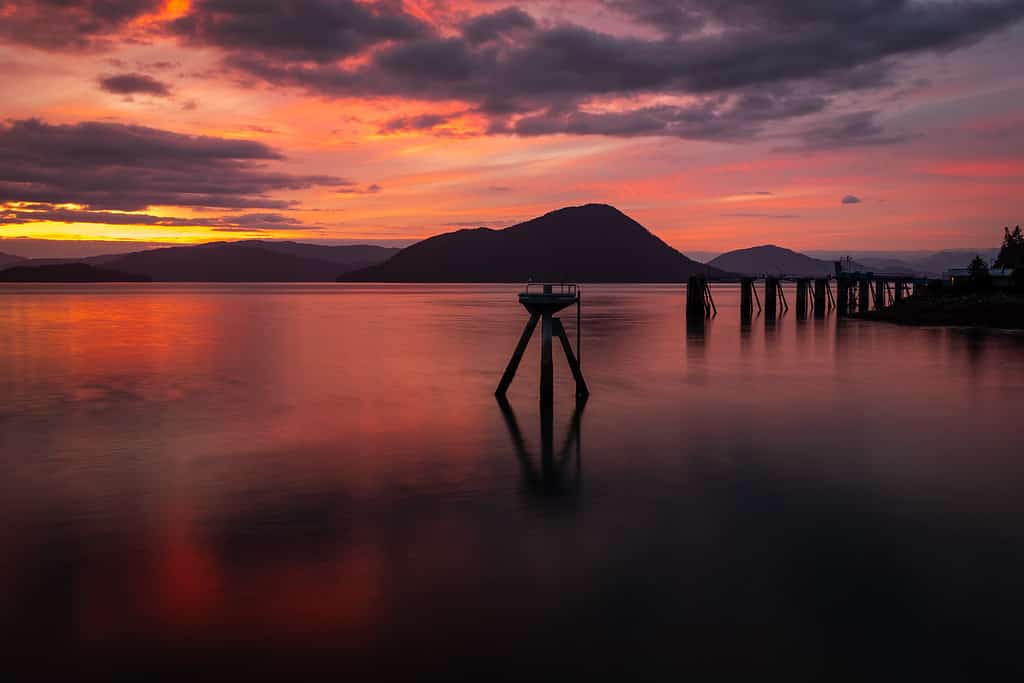
Wrangell Island boasts incredible coastal vistas.
©2checkingout/ via Getty Images
Fox Island
Residing in the waters of Resurrection Bay near Seward, AK, Fox Island is a captivating coastal treasure waiting to enchant visitors with its remote beauty. This island is part of the stunning Kenai Fjords National Park. It holds a special charm due to its secluded, unspoiled wilderness.
Covering an area of approximately 3.2 miles long (5.1 kilometers) and 2 miles wide (3.2 kilometers), Fox Island is a relatively small island. However, it packs a big punch when it comes to unique attractions and holds a special place on our list of must-visit islands in Alaska. From the early to mid-20th century, Fox Island was home to fox farms, hence how it got its name. One of its most remarkable features is the enchanting landscape, characterized by rugged coastlines, lush forests, and breathtaking vistas from its shores. This mighty island’s charm lies in its conserved nature.
Attractions on Fox Island
Though small, Fox Island has numerous attractions. As part of Kenai Fjords National Park, visitors can indulge in camping, hiking, and backpacking while immersing themselves in the splendor of the natural world. Guided tours allow adventurers to witness the awe-inspiring beauty of the surrounding glaciers and abundant marine life. Kayaking through the serene waters enables visitors to explore hidden coves and spot marine life up close. In the waters around Fox Island, fishing and crabbing enthusiasts can also indulge, with the possibility of catching a variety of fish or crab species. Some species found here include several salmon species (Salmo salar), Pacific halibut (Hippoglossus stenolepis), and even Dungeness crab (Metacarcinus magister).
One of the unique attractions on Fox Island is the Kenai Fjords Wilderness Lodge, a rustic and charming lodge offering a cozy retreat in the heart of the wilderness. Furthermore, visitors can experience the tranquility of the island and immerse themselves in the natural wonders surrounding them.
Moreover, the island’s diverse habitats support a variety of animal species. One unique creature on Fox Island is the Tufted Puffin (Fratercula cirrhata). These intriguing creatures prefer to breed in colonies on islands like Fox Island, with steep, grassy slopes or cliff tops. The island’s flora is equally captivating, with unique plant species such as the elderberry (Sambucus racemosa) and Lady fern (Athyrium filix-femina). These plants thrive in the Kenai Fjords National Park’s coastal environment, which includes Fox Island.
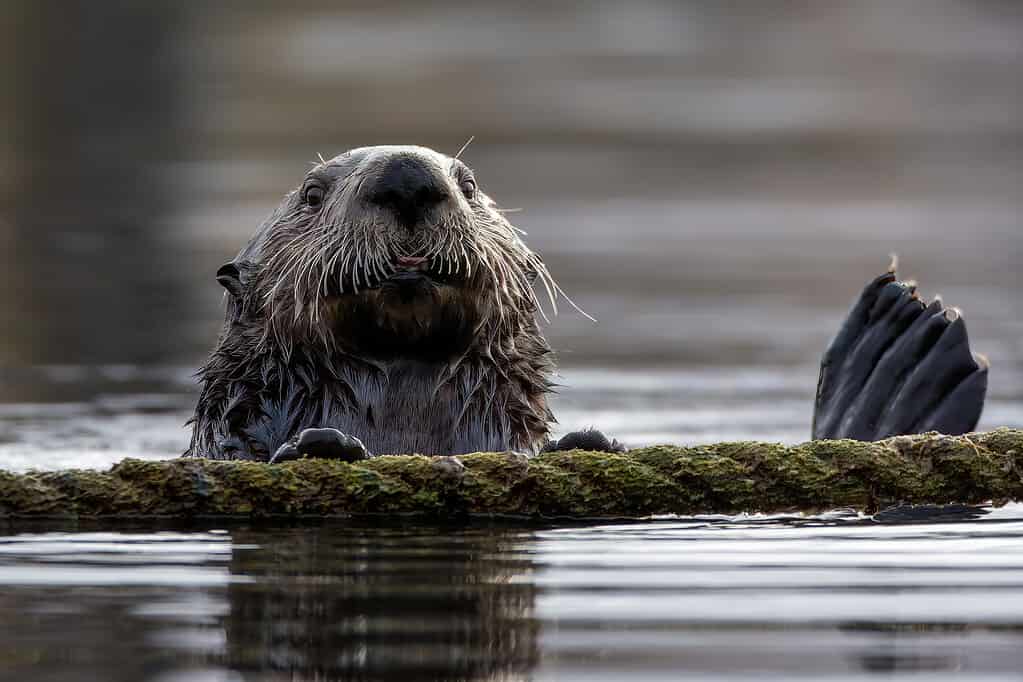
Alaskan Sea Otters inhabit the waters of Fox Island’s coastline and many other island coastlines.
©Kyle Moon/ via Getty Images
Chichagof Island
Tucked away in the southeastern region of Alaska, Chichagof Island is similar to the breathtaking landscapes and remarkable biodiversity of Admiralty Island and Baranof Island. It is seventh on our list of must-visit islands in Alaska.
Encompassing an expansive area of approximately 2,048 square miles (5,305 square kilometers), Chichagof Island teems with an incredible array of natural wonders across its vast landscape. It is another of Alaska’s islands with a high brown bear (Ursus arctos) concentration. Furthermore, it is fondly referred to as the “Bear Island.” Chichagof Island offers a generous opportunity to witness these striking animals roaming freely in their natural habitat. This makes it a must-visit destination for those seeking extraordinary wildlife.
Attractions on Chichagof Island
The island is north of a part of Baranof Island and west of Admiralty Island. The Tongass National Forest covers a significant area of the island as well. Here, visitors can embark on remarkable adventures. Some activities include camping, backpacking, hunting, winter activities, and hiking, amongst other activities such as chartering an aircraft or boat. Like most other islands, water activities are quite popular here, offering plentiful opportunities to explore and experience Alaska by water.
Beyond its famed brown bears, Chichagof Island is home to other unique animal species. Some species include the bald eagles (Haliaeetus leucocephalus), harbor seals (Phoca vitulina), and mink (Neovison vision). All of which are common roaming the coastal areas.
Overall, Chichagof Island is a wilderness haven. It has verdant forests with unique plant species like the Sitka spruce (Picea sitchensis) and Western hemlock (Tsuga heterophylla). All of which paint a lush canvas.
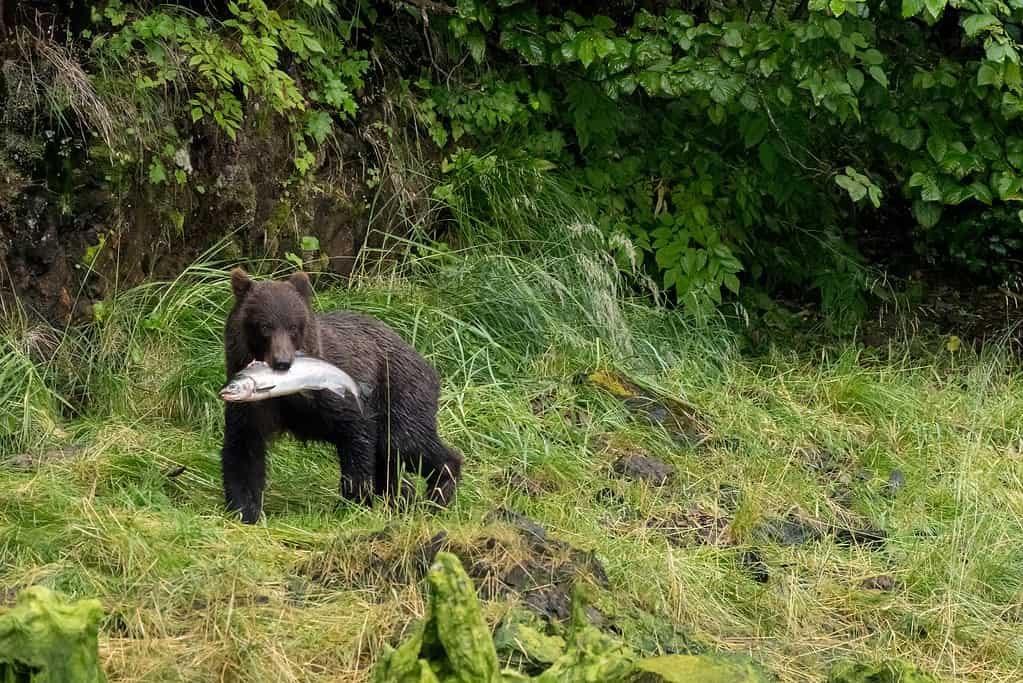
Brown bears are incredibly common on Chichagof Island, Admiralty Island, and Baranof Island.
©Kirk Hewlett/ via Getty Images
Adak Island
Adak Island’s wild beauty, geothermal wonders, and captivating history make it an off-the-beaten-path destination. It promises a once-in-a-lifetime Alaskan adventure for those willing to embark on its remote location. It is another unique island on our list of must-visit islands in Alaska.
In the far-flung reaches of Alaska’s Andreanof Islands, Adak Island is a true example of the state’s untamed environment. Moreover, it is one of the southernmost islands in the chain, surrounded by the vast expanse of the North Pacific Ocean. Extreme weather conditions shape the landscape here.
Spanning approximately 275 square miles (711 square kilometers), Adak Island has a subpolar oceanic climate and a tundra-like landscape. It showcases otherwordly natural wonders and its intriguing history’s remnants.
Attractions on Adak Island
One unique feature of the island is its fascinating geothermal activity. It has natural hot springs bubbling amidst the coastal terrain, adding a touch of volcanic mystique to the landscape.
Despite its remote location, Adak Island offers a wealth of attractions for adventurous souls seeking remote wilderness and small-town experiences. The island is known for its exceptional fishing opportunities. It attracts anglers in pursuit of Pacific halibut (Hippoglossus stenolepis), Pacific cod (Gadus macrocephalus), and salmon (Salmo salar), to name a few species. The commercial fish processing industry mainly supports the island’s economy. The surrounding waters also provide chances for whale-watching.
Moreover, the island’s rugged terrain is perfect for hiking, hunting, bear-free camping or backpacking, and wildlife observation. Visitors can also charter an aircraft or boat to enjoy unique experiences. Adak Island’s diverse habitats support a variety of animal species, including the Aleutian cackling goose (Branta hutchinsii leucopareia).
The island also has a fascinating military history. The island served as a strategic naval base during World War II and the Cold War. Remnants of its military past, such as abandoned buildings and infrastructure, now add an eerie element to the island’s landscape.

Adak Island is one of the most remote islands in Alaska and is located on the southernmost chain of the Andreanof Islands.
©James B Williams Photography/ via Getty Images
Douglas Island
In the heart of Alaska’s Inside Passage, Douglas Island is a captivating place next to the Gastineau Channel. The island is adjacent to the capital city of Juneau. This island made it on our list of must-visit islands in Alaska. It provides easy access to the region’s stunning natural wonders and historical riches.
Furthermore, it covers an area of approximately 77 square miles (199 square kilometers). This island holds a combination of stunning landscapes. As well as remnants of its mining and logging history, creating a captivating tapestry of natural and man-made attractions.
Attractions on Douglas Island
For those seeking an unforgettable Alaskan adventure, Douglas Island offers a wealth of opportunities to explore. The island is home to the Eaglecrest Ski Area. This ski area provides an opportunity for winter sports enthusiasts to hit the slopes. It also allows visitors to marvel at breathtaking vistas of the surrounding mountains and waters.
Moreover, the diverse terrain, yet convenient location, of Douglas Island makes it a paradise for visitors. Hikers and backpackers can enjoy numerous trails offering stunning views. Visitors can also indulge in outdoor activities like fishing, water activities, winter activities, charter an aircraft or boat, and birdwatching.
There is also much to discover in Douglas Island’s unique heritage. The Treadwell Mine Ruins offer insight into the island’s mining past and a glimpse into the region’s rich mining history. The historic Last Chance Mining Museum, in nearby Juneau, further immerses visitors in the island’s storied past.
Furthermore, Douglas Island’s natural habitats provide a home to a mixture of wildlife species. Unique animal encounters may include many species. Some species include the Steller’s Jay (Cyanocitta stelleri) and the Marten (Martes americana) inhabiting the island’s forests and grasslands. The island’s flora is equally gorgeous, with unique plant species like the Yellow cedar (Callitropsis nootkatensis) and Salmonberry (Rubus spectabilis).
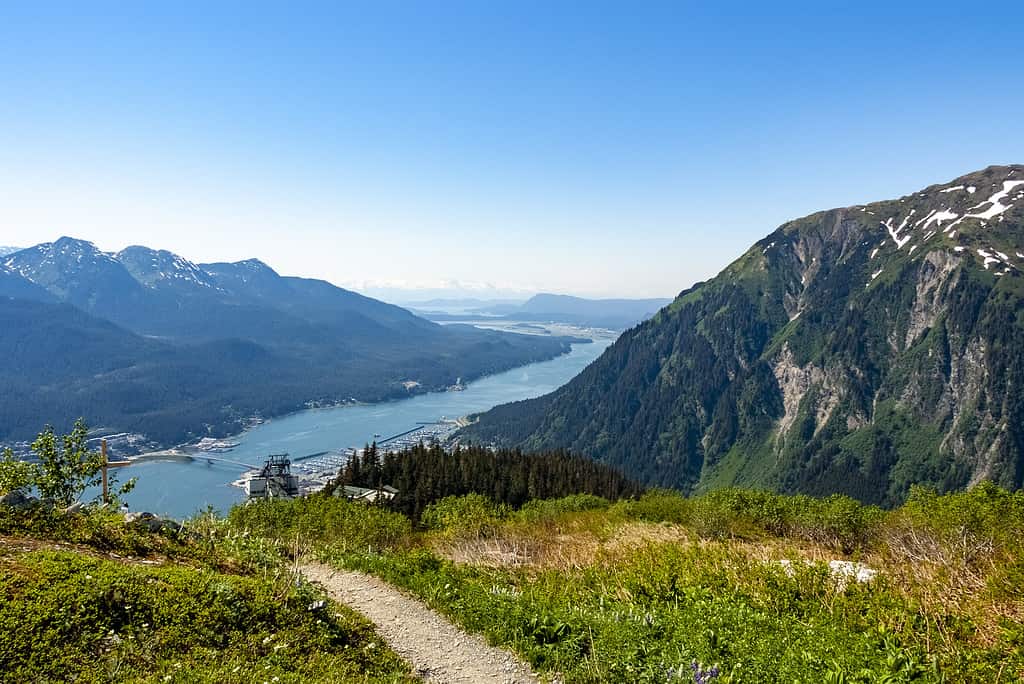
Douglas Island, and the majority of other islands in Alaska, are teeming with hiking trails.
©ad_foto/ via Getty Images
Revillagigedo Island
Last on our list of must-visit islands in Alaska is Revillagigedo Island. It is a natural wonderland with charming small-town energy. This breathtaking island is home to the coastal town of Ketchikan and covers approximately 1,060 square miles (2,754 square kilometers).
Attractions on Revillagigedo Island
Revillagigedo Island is filled with untouched landscapes and unparalleled biodiversity. The island’s rugged coastline, dense forests, and mountains create a majestic scene. This island also hosts the Tongass National Forest. It is filled with natural treasures and offers abundant opportunities. Some activities include camping, backpacking, and hiking amidst old-growth forests and unspoiled wilderness.
Moreover, Revillagigedo Island invites fishing enthusiasts to its waters. Its waters are teeming with abundant fish species, including salmon (Salmo salar) and Cutthroat trout (Oncorhynchus clarkii). For those seeking marine adventures, coating tours are available. If you’re interested in cruise ships, this is a common stopping point for many cruise ship journeys.
Alaska is home to various gray wolf species (Canis lupus) uniquely adapted to Alaskan habitats. The elusive Marbled murrelet (Brachyramphus marmoratus), a small seabird, also calls this island home, nesting high in the towering trees.
Finally, Revillagigedo Island hosts an array of unique plant species. Notable examples include the Lodgepole pine (Pinus contorta) and the Western redcedar (Thuja plicata). These towering conifers dominate the island’s temperate rainforest. The interesting Devil’s Club (Oplopanax horridus) thrives in the understory, showcasing its distinctive thorns and large leaves.

Ketchikan, located on Revillagigedo Island, is a charming coastal town filled with history.
©jsnover/ via Getty Images
Summary of 10 Must-Visit Islands in Alaska
| Rank | Must-Visit Island | Location |
|---|---|---|
| 1 | Kodiak Island | southwest of Anchorage |
| 2 | Prince of Wales Island | the Alexander Archipelago in the Alaska Panhandle |
| 3 | Admiralty Island | 15 miles southwest of Juneau |
| 4 | Baranof Island | Sitka, in the Alexander Archipelago in the Alaska Panhandle |
| 5 | Wrangell Island | in the Alexander Archipelago in the Alaska Panhandle of southeastern corner |
| 6 | Fox Island | Resurrection Bay near Seward |
| 7 | Chichagof Island | in the Alexander Archipelago of the Alaska Panhandle |
| 8 | Adak Island | Near the western extent of the Andreanof Islands group of the Aleutian Islands |
| 9 | Douglas Island | Adjacent to the capital city of Juneau |
| 110 | Revillagigedo Island | Alexander Archipelago in Ketchikan Gateway Borough of the southeastern region |
The photo featured at the top of this post is © NancyS/Shutterstock.com
Thank you for reading! Have some feedback for us? Contact the AZ Animals editorial team.







